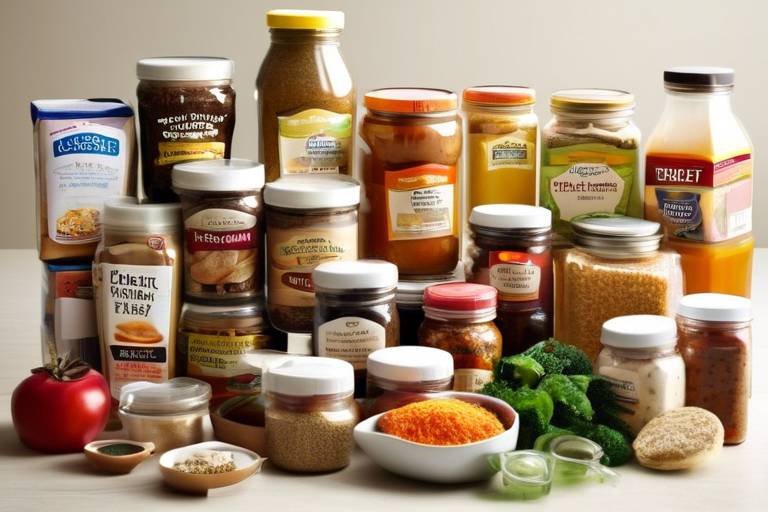How to Keep Your Family's Diet Balanced and Nutritious
In today's fast-paced world, maintaining a balanced and nutritious diet for your family can feel like a daunting task. But fear not! With a little planning and creativity, you can ensure that every meal is both delicious and packed with the essential nutrients your family needs. The key lies in understanding the importance of variety, moderation, and making informed food choices. So, let's dive into some practical strategies that can transform your family's eating habits into a healthier, happier lifestyle!
Every family member has unique nutritional requirements, which can vary based on age, activity level, and health conditions. For instance, children need more calcium for growing bones, while adults may require more fiber to aid digestion. Understanding these needs is crucial in planning meals that cater to everyone in the family. By doing so, you can ensure that each meal is a powerhouse of essential nutrients, helping your loved ones thrive. It's like being a chef in a restaurant where the menu changes daily to suit the tastes and needs of your diners!
Variety is the spice of life, especially when it comes to nutrition! Including different food groups and flavors in your meals not only keeps things interesting but also provides a wider range of nutrients. Imagine your plate as a colorful palette—each food group adds its unique hue and flavor. To achieve this, aim to include a mix of fruits, vegetables, whole grains, and proteins at every meal. This approach not only satisfies hunger but also keeps your family excited about mealtime.
Fruits and vegetables are vital for health, acting as nature's multivitamins. They are packed with vitamins, minerals, and antioxidants that help boost the immune system and protect against diseases. To incorporate more of these colorful foods into your family's daily meals and snacks, consider the following tips:
- Make it a habit: Keep a bowl of fresh fruits on the kitchen counter for easy snacking.
- Blend it up: Add spinach or kale to smoothies for a nutrient boost without compromising taste.
- Get creative: Use vegetables in unexpected ways, like spiralizing zucchini into noodles!
Choosing seasonal produce not only enhances flavor but also supports local farmers. Seasonal fruits and vegetables are usually fresher and more affordable. To select and prepare seasonal produce for your family, visit local farmers' markets or grocery stores that highlight seasonal items. This not only introduces your family to new flavors but also teaches them the importance of sustainability and supporting local businesses.
Experimenting with different cooking methods can make vegetables more appealing. Instead of boiling broccoli until it's mushy, try roasting it with a drizzle of olive oil and a sprinkle of salt for a crispy, flavorful side dish. Steaming and grilling are also fantastic options that preserve nutrients while enhancing taste. By making vegetables more enticing, you're more likely to see your family reaching for seconds!
Whole grains and lean proteins provide essential energy and nutrients that keep your family fueled throughout the day. Incorporating foods like quinoa, brown rice, and whole-grain bread can significantly boost fiber intake, promoting better digestion. Similarly, lean proteins such as chicken, fish, beans, and legumes are essential for muscle repair and growth. Try mixing quinoa into salads or using beans as a meat substitute in tacos for a nutritious twist!
Meal planning simplifies the process of maintaining a nutritious diet. By setting aside a little time each week to plan your meals, you can ensure that you have all the ingredients you need on hand, minimizing waste and last-minute unhealthy choices. Start by mapping out meals that include a balance of fruits, vegetables, whole grains, and proteins. This strategy not only saves time but also helps you stick to your nutritional goals.
Understanding portion sizes is crucial for a balanced diet. Teaching your family about appropriate portions can prevent overeating and promote healthy eating habits. Use smaller plates to visually trick the brain into feeling satisfied with less food. You can also encourage your family to listen to their hunger cues, eating slowly and stopping when they feel full. It’s like training for a marathon—you need to pace yourself for the best results!
Getting the whole family involved in meal preparation fosters a sense of teamwork and encourages healthier eating choices. Whether it's chopping vegetables, mixing ingredients, or setting the table, involving everyone makes cooking a fun and educational experience. Plus, it’s a great way to bond! Try hosting a family cooking night where everyone can collaborate on a new recipe, turning mealtime into an adventure.
Q: How can I encourage my kids to eat more vegetables?
A: Try making vegetables fun! Use cookie cutters to create shapes, or involve them in cooking to spark their interest.
Q: What are some quick and healthy snack ideas?
A: Fresh fruit, yogurt with granola, or whole grain crackers with hummus are great options that are both nutritious and easy to prepare.
Q: How often should I introduce new foods to my family?
A: Aim to introduce new foods at least once a week. It can take several tries before someone develops a taste for something new, so be patient!

Understanding Nutritional Needs
Every family member has unique nutritional requirements that are influenced by factors such as age, sex, activity level, and health conditions. Understanding these needs is crucial for planning meals that cater to the diverse needs of your family. For instance, children require more calcium and iron for growth, while adults may need to focus on heart-healthy options. It's like creating a personalized recipe for health; if you miss an ingredient, the dish might not turn out as delicious or nutritious as you hoped.
To ensure everyone receives essential nutrients, consider the following key nutritional components:
- Macronutrients: These include carbohydrates, proteins, and fats. Each plays a vital role in providing energy and supporting bodily functions.
- Micronutrients: Vitamins and minerals are essential for optimal health. They help in processes like immune function and bone health.
- Fiber: Important for digestive health, fiber can be found in fruits, vegetables, and whole grains.
When planning meals, it's beneficial to consider the specific nutritional needs of each family member. For example, teenagers might need more protein to support their growth spurts, while older adults may benefit from increased fiber to aid digestion. A well-rounded approach not only ensures that everyone is nourished but also promotes a healthy relationship with food.
Another aspect to consider is how medical conditions can influence dietary needs. For instance, individuals with diabetes may need to monitor their carbohydrate intake closely, while those with high blood pressure should focus on reducing their sodium intake. Understanding these specific requirements can help in making informed food choices that benefit everyone.
In conclusion, by taking the time to understand the nutritional needs of each family member, you can create meals that are not only balanced but also enjoyable. It's all about making informed choices that cater to the unique needs of your family, ensuring that everyone thrives in their health journey.
- What are the basic nutritional needs for children? Children typically require more vitamins and minerals, particularly calcium and iron, to support their growth and development.
- How can I ensure my family is getting enough fiber? Incorporate more fruits, vegetables, whole grains, and legumes into your meals to boost fiber intake.
- Are there specific diets for older adults? Yes, older adults may benefit from diets that focus on heart health, low sodium, and high fiber to support digestion and overall health.

Incorporating Variety in Meals
When it comes to keeping your family's diet balanced and nutritious, variety is not just the spice of life—it’s a fundamental ingredient for health! Imagine your meals as a colorful canvas where each food group adds a unique shade and texture. By incorporating a wide range of foods, you not only enhance the nutritional value of your meals but also make them more exciting and appealing to everyone at the table.
One of the easiest ways to introduce variety is by exploring different food groups. For instance, aim to fill half your plate with fruits and vegetables, a quarter with whole grains, and the remaining quarter with lean proteins. This simple approach ensures that each meal is not only balanced but also bursting with flavors and textures that can satisfy even the pickiest eaters.
But how do you keep things interesting? Here are a few strategies to consider:
- Mix Up Your Ingredients: Instead of serving the same vegetables every week, try rotating through a variety of options. Think about incorporating seasonal produce, which can bring freshness and new flavors to your meals.
- Experiment with Global Cuisines: Why not take your family on a culinary journey? Each week, choose a different cuisine to explore, whether it's Italian, Thai, or Mexican. This not only introduces new ingredients but also teaches your family about different cultures.
- Try New Cooking Techniques: Sometimes, how you prepare food can make all the difference. Roasting, grilling, or stir-frying can change the texture and flavor profile of vegetables, making them more appealing to your family.
Let’s not forget about the importance of color. A plate filled with a rainbow of fruits and vegetables not only looks appetizing but also ensures a wide range of nutrients. For example, dark leafy greens like spinach and kale are rich in iron and calcium, while vibrant bell peppers provide a hefty dose of vitamin C. By consciously choosing colorful foods, you can maximize the health benefits while keeping your meals visually appealing.
Furthermore, don’t shy away from involving your kids in the process! When children participate in selecting and preparing meals, they are more likely to try new foods. Set up a family night where everyone can pick a new fruit or vegetable to include in the week’s menu. This not only fosters a sense of teamwork but also encourages healthy eating habits from a young age.
In summary, incorporating variety in meals is a fun and rewarding journey that can transform your family’s eating habits. By mixing different food groups, experimenting with global cuisines, and engaging your family in meal preparation, you can create balanced and nutritious meals that everyone will look forward to. Remember, a little creativity goes a long way in making healthy eating a delightful experience!
Q: How can I encourage my picky eater to try new foods?
A: Try involving them in meal planning and preparation. Let them choose a new fruit or vegetable at the grocery store, and encourage them to help with cooking. Making food fun and engaging can spark their interest!
Q: What are some easy ways to add more fruits and vegetables to meals?
A: You can add fruits and vegetables to smoothies, incorporate them into sauces, or serve them as snacks with dips like hummus. Sneaking them into favorite dishes can also help.
Q: How often should I introduce new foods to my family?
A: Aim to introduce at least one new food each week. This keeps meals interesting and helps your family develop a taste for different flavors over time.

Fruits and Vegetables
When it comes to maintaining a balanced and nutritious diet for your family, are the superheroes of the food world! Not only do they add a burst of color to your meals, but they also pack a powerful punch of essential vitamins, minerals, and antioxidants that your body craves. Imagine your plate as a canvas, with each vibrant fruit and vegetable acting as a brushstroke that contributes to a masterpiece of health. But how do we ensure that our family is getting enough of these nutritional powerhouses?
First off, it’s crucial to make fruits and vegetables a regular part of your family’s meals and snacks. Think about it: when was the last time you saw a child turn down a juicy, sweet strawberry or a crunchy carrot stick? By incorporating these foods into everyday dishes, you're not only providing vital nutrients but also teaching your family to appreciate the natural flavors of healthy foods. And let’s be honest, who doesn’t want to crunch into a fresh apple or munch on some colorful bell peppers?
To keep things exciting, consider the following tips to boost fruit and vegetable intake:
- Mix it Up: Try to include a variety of colors and types of fruits and vegetables in each meal. This not only makes your plate visually appealing but also ensures a broader range of nutrients.
- Snack Smart: Keep a bowl of fresh fruit on the kitchen counter or pack some veggie sticks in lunchboxes. Having healthy snacks readily available encourages everyone to reach for them instead of processed options.
- Get Creative: Blend fruits into smoothies, add spinach to pasta dishes, or make a colorful salad with a mix of greens, tomatoes, and cucumbers. The more creative you get, the more your family will enjoy these foods!
Another fantastic way to incorporate seasonal fruits and vegetables into your meals is by visiting local farmers' markets. Not only do you get to support local agriculture, but you also gain access to the freshest produce available. Seasonal choices often taste better and are more nutritious, as they are harvested at their peak ripeness. Plus, involving your family in selecting fruits and vegetables can be a fun outing that encourages them to try new things.
As you explore the world of fruits and vegetables, don’t forget about the different cooking methods that can make these foods more appealing. Roasting vegetables can enhance their natural sweetness, while steaming retains most of their nutrients. Grilling adds a smoky flavor that can make even the most reluctant veggie eater give them a second chance. The key is to experiment with flavors and textures to find what your family enjoys the most.
In conclusion, making fruits and vegetables a staple in your family's diet is not just about health; it’s about creating a love for nutritious food that lasts a lifetime. So, roll up your sleeves, get creative in the kitchen, and make every meal an opportunity to celebrate the vibrant world of fruits and vegetables!
Q: How can I encourage my kids to eat more fruits and vegetables?
A: Get them involved in the selection and preparation process! Let them pick out fruits and vegetables at the store or farmers' market, and involve them in cooking. Making it a fun family activity can spark their interest in trying new foods.
Q: Are frozen fruits and vegetables just as nutritious as fresh ones?
A: Yes! Frozen fruits and vegetables are often picked at their peak ripeness and flash-frozen, which helps preserve their nutrients. They can be a convenient and affordable option for busy families.
Q: What are some easy ways to add more fruits and vegetables to meals?
A: You can add spinach or kale to smoothies, mix grated carrots or zucchini into muffins, or top your pizza with bell peppers and mushrooms. The possibilities are endless!

Seasonal Choices
Choosing seasonal produce is not just about eating what's fresh; it's an opportunity to enhance the flavor of your meals while supporting local farmers and the environment. When you opt for fruits and vegetables that are in season, you're not only getting the best taste but also the highest nutritional value. Think about it: a juicy summer tomato picked at its peak ripeness will always beat a mealy one shipped from thousands of miles away. Plus, seasonal foods often come with a lower price tag, making it easier on your wallet!
So, how do you go about selecting and preparing these seasonal delights? Start by visiting your local farmers' market or grocery store that emphasizes local produce. You might be surprised by the variety available! Here’s a quick guide to help you understand what’s typically in season:
| Season | Fruits | Vegetables |
|---|---|---|
| Spring | Strawberries, Cherries | Asparagus, Spinach, Peas |
| Summer | Tomatoes, Peaches, Watermelon | Cucumbers, Bell Peppers, Zucchini |
| Fall | Apples, Pears, Pumpkins | Carrots, Sweet Potatoes, Brussels Sprouts |
| Winter | Citrus Fruits, Pomegranates | Root Vegetables, Kale, Cabbage |
By incorporating these seasonal choices into your family meals, you can create vibrant dishes that are not only healthy but also visually appealing. Imagine a colorful salad bursting with ripe tomatoes, crisp cucumbers, and bright bell peppers during the summer months! To make the most of these seasonal ingredients, consider experimenting with different cooking methods. Roasting root vegetables in the fall or grilling fresh summer corn can bring out their natural sweetness and make them more enticing for your family.
Moreover, seasonal eating encourages a sustainable lifestyle. It reduces the carbon footprint associated with transporting food long distances and supports local agriculture. So, every time you choose seasonal produce, you're not only nourishing your family but also contributing to the health of your community and planet.
In conclusion, embracing seasonal choices is a simple yet impactful way to enhance your family's diet. It invites a sense of adventure into your cooking while ensuring that everyone at the table is getting the best nutrition possible. So, next time you're planning your meals, remember to check what's in season and get ready to enjoy the flavors of each unique time of year!
- Why is it important to eat seasonal produce? Eating seasonal produce ensures you get the freshest and most nutritious options while supporting local farmers.
- How can I find out what fruits and vegetables are in season? Check local farmers' markets, grocery stores, or online resources that list seasonal produce in your area.
- What are some creative ways to cook seasonal vegetables? Try roasting, grilling, or steaming to enhance their flavors and make them more appealing to your family.

Creative Cooking Methods
When it comes to making vegetables more appealing, sometimes all it takes is a little creativity in the kitchen. Think of cooking as a canvas, and your ingredients as the vibrant colors waiting to be transformed into a masterpiece. By experimenting with different cooking methods, you can elevate the humble vegetable into a star dish that even the pickiest eaters will love. So, how do you make those greens pop? Let’s dive into some exciting cooking techniques!
One of the most popular methods is roasting. This technique caramelizes the natural sugars in vegetables, creating a rich, sweet flavor that’s hard to resist. Imagine biting into a perfectly roasted carrot, its edges slightly crispy and its center tender. To roast vegetables, simply toss them in a bit of olive oil, sprinkle with salt and pepper, and place them in a preheated oven. You can even add herbs like rosemary or thyme for an aromatic twist. Here’s a quick guide on how to roast various vegetables:
| Vegetable | Temperature (°F) | Cooking Time (minutes) |
|---|---|---|
| Carrots | 400 | 25-30 |
| Brussels Sprouts | 400 | 20-25 |
| Sweet Potatoes | 425 | 30-35 |
Another fantastic method is steaming. This technique preserves the nutrients in vegetables while keeping them vibrant and crisp. Steaming is like giving your veggies a spa day; they come out refreshed and ready to shine on your plate. You can use a traditional steamer or even a microwave-safe bowl with a lid. Just remember to keep an eye on the clock to avoid overcooking.
And let’s not forget about grilling! Grilling adds a smoky flavor and beautiful char marks that can make any vegetable dish feel gourmet. Zucchini, bell peppers, and asparagus are all excellent choices for the grill. Just brush them with a little olive oil, season with salt and pepper, and place them directly on the grill. The result? A delicious side that can turn a simple meal into an unforgettable feast.
Lastly, don’t shy away from stir-frying. This quick cooking method is perfect for busy families, allowing you to toss a variety of vegetables together in one pan. With a splash of soy sauce or teriyaki, you can create a colorful, flavorful dish in minutes. Plus, the high heat helps to retain the crunchiness of the veggies, making them more enjoyable to eat.
Incorporating these creative cooking methods not only makes vegetables more appealing but also introduces your family to a world of flavors and textures. So, why not grab some fresh produce and start experimenting? You might just find a new family favorite that keeps everyone coming back for more!
- What are some easy vegetables to start with when trying new cooking methods? Carrots, bell peppers, and broccoli are great choices due to their versatility.
- Can I use frozen vegetables for these cooking methods? Absolutely! Frozen vegetables can be just as nutritious and often require less prep time.
- How do I know when my vegetables are done cooking? Look for vibrant colors and a tender texture. A fork should easily pierce through them.

Whole Grains and Proteins
When it comes to building a healthy diet for your family, whole grains and proteins are the dynamic duo you don’t want to overlook. Whole grains are packed with fiber, vitamins, and minerals, making them an essential part of any meal. They not only provide energy but also help in maintaining a healthy digestive system. Think of them as the sturdy foundation of a house; without a solid base, everything else can crumble. On the other hand, proteins are the building blocks of life. They are crucial for growth, repair, and overall health. Incorporating both of these food groups into your family’s meals can make a world of difference!
So, how can you easily integrate whole grains and proteins into your family's daily diet? Start by swapping out refined grains for whole grains. For instance, instead of white rice, try brown rice or quinoa. Not only do these options offer more nutrients, but they also add a delightful nutty flavor to your dishes. Similarly, when it comes to bread, choose whole grain or whole wheat varieties. Your sandwiches will not only taste better, but they will also keep you fuller for longer!
Now, let’s talk about proteins. Lean meats, fish, eggs, beans, and legumes are all excellent sources. A simple way to ensure your family is getting enough protein is by including a source in every meal. For example, if you're whipping up a stir-fry, toss in some chicken or tofu along with a variety of colorful veggies. This not only enhances the meal's nutritional profile but also makes it visually appealing. Remember, variety is key! Try rotating different protein sources throughout the week to keep things exciting and to ensure you're covering all your nutritional bases.
Here’s a quick comparison table of whole grains and their protein content:
| Whole Grain | Protein Content (per 100g) |
|---|---|
| Quinoa | 4.1g |
| Brown Rice | 2.6g |
| Oats | 2.5g |
| Barley | 2.3g |
Incorporating whole grains and proteins doesn’t have to be a chore. Get your family involved in meal planning and preparation! Ask your kids to choose a whole grain or protein they want to try each week. This not only makes them more excited about the meals but also teaches them valuable lessons about nutrition. Plus, cooking together can be a fun bonding experience. Who wouldn’t want to make dinner a family affair?
Finally, don’t forget to keep an eye on portion sizes. While whole grains and proteins are nutritious, consuming them in excess can lead to unwanted weight gain. Teach your family about appropriate portions by using visual aids, such as comparing a serving of rice to the size of a fist or a serving of meat to the size of a deck of cards. This way, everyone can enjoy their meals without overindulging.
- What are some easy whole grain options for kids? Try whole grain pasta, brown rice, or whole grain pancakes to make it fun and tasty!
- How can I make proteins appealing to picky eaters? Experiment with different cooking methods and flavors, like marinating chicken or adding spices to beans.
- How much protein does my family need daily? It varies by age and activity level, but generally, aim for about 0.8 grams of protein per kilogram of body weight.

Planning Balanced Meals
Meal planning is like creating a roadmap to a healthier lifestyle for your family. It simplifies the process of maintaining a nutritious diet, ensuring that everyone gets the essential nutrients they need without the stress of last-minute decisions. Imagine walking into your kitchen with a clear plan, knowing exactly what to cook and how to satisfy the diverse tastes of your family members. This not only saves time but also minimizes waste, allowing you to make the most out of your grocery budget.
To start planning balanced meals, it's crucial to understand the components of a nutritious plate. A well-balanced meal typically includes:
| Food Group | Recommended Portion | Examples |
|---|---|---|
| Fruits and Vegetables | Half of your plate | Leafy greens, berries, carrots |
| Whole Grains | One quarter of your plate | Brown rice, quinoa, whole grain pasta |
| Lean Proteins | One quarter of your plate | Chicken, fish, beans |
When planning meals, consider the time you have during the week. Are there days when you’re busier than others? If so, you might want to prepare larger meals on weekends that can be enjoyed as leftovers during the week. This not only saves time but also encourages the use of wholesome ingredients that can be easily reheated. You can even get creative with your leftovers; for example, roasted chicken can be transformed into a delicious chicken salad or a hearty soup.
Another tip is to involve your family in the meal planning process. Ask each member what their favorite meals are and try to incorporate those into your weekly plan. This not only makes everyone feel included but also reduces the chances of food going uneaten. You can create a fun family tradition by sitting down together each week to brainstorm meal ideas. This could be as simple as a rotating schedule where each family member picks one meal for the week!
Don't forget about snacks! Healthy snacking can be part of your meal planning. Instead of reaching for chips or sugary treats, stock up on nutritious options like:
- Fresh fruits
- Vegetable sticks with hummus
- Yogurt with nuts
These snacks can be prepared in advance and kept handy for those busy days when everyone is rushing around. Having healthy snacks readily available can help curb hunger and prevent poor food choices.
Finally, remember that flexibility is key. Life happens, and sometimes plans change. It's perfectly fine to swap meals around or adjust recipes based on what you have on hand. The goal is to create a balanced diet that works for your family, making it sustainable and enjoyable. So, embrace the journey of meal planning, and watch as your family's health and happiness flourish!
Q: How do I get my kids to eat more vegetables?
A: Involve them in the cooking process! Let them choose a vegetable at the store and help prepare it at home. Making veggies fun, such as creating colorful salads or veggie skewers, can also entice them to eat more greens.
Q: How can I save time on meal prep?
A: Consider batch cooking on weekends. Prepare larger portions of grains, proteins, and vegetables that can be mixed and matched throughout the week. Using a slow cooker or instant pot can also save time.
Q: What if I have picky eaters?
A: Try introducing new foods alongside familiar favorites. Be patient and keep offering a variety of foods without pressure. Sometimes, it takes multiple exposures for a child to accept a new food.

Portion Control
Understanding portion sizes is crucial for maintaining a balanced diet, particularly in a family setting where diverse appetites and nutritional needs converge. Have you ever found yourself dishing out more than you intended, only to realize that half of it goes uneaten? It’s a common scenario, and it often leads to food waste and unhealthy eating habits. By teaching your family about appropriate portion sizes, you can help prevent overeating and promote healthier eating habits.
One effective way to manage portions is to use smaller plates and bowls. This simple trick can create the illusion of a fuller plate, making it easier for everyone to feel satisfied with less food. Consider this: when you fill a large plate, it can easily lead to piling on more food than necessary, but a smaller plate encourages mindful eating. Additionally, serving food in the kitchen rather than at the table can help control how much each person takes, reducing the temptation to go back for seconds.
Another strategy is to educate your family on what constitutes a healthy portion. For example, a serving of protein should be about the size of a deck of cards, while a serving of grains should fit in the palm of your hand. Here’s a quick reference table to illustrate some common portion sizes:
| Food Group | Recommended Portion Size |
|---|---|
| Fruits | 1 medium piece or 1 cup chopped |
| Vegetables | 1 cup raw or ½ cup cooked |
| Grains | 1 slice of bread or ½ cup cooked pasta/rice |
| Protein | 3 ounces cooked (about the size of a deck of cards) |
| Dairy | 1 cup milk or yogurt, 1.5 ounces cheese |
Involving the family in discussions about portion sizes can also foster a collaborative environment. Have a family meeting where everyone can share their thoughts on how much food they feel comfortable eating. This can be particularly helpful for children, as they learn to listen to their bodies and understand their hunger cues. Encourage them to ask themselves questions like, “Am I really hungry, or am I just bored?” This self-awareness is key to developing a healthy relationship with food.
Moreover, consider implementing a “plate method” during meals. This method divides the plate into sections: half should be filled with fruits and vegetables, one quarter with lean protein, and the last quarter with whole grains. This visual guide makes it easier for everyone to understand the right proportions at a glance, ensuring that meals are balanced and nutritious.
Lastly, remember that portion control isn’t just about the food itself; it’s also about the environment in which you eat. Encourage family meals at the table without distractions like television or smartphones. This not only promotes mindful eating but also enhances family bonding time. By focusing on each bite, your family can better recognize when they are full, leading to a more satisfying dining experience.
- What is the best way to teach children about portion control? Start by using visual aids, such as the plate method, and involve them in meal planning and preparation.
- How can I avoid food waste while practicing portion control? Serve smaller portions initially and encourage family members to ask for more if they are still hungry.
- Are there any apps that can help with portion control? Yes, there are several nutrition tracking apps that can help you and your family monitor portion sizes and nutritional intake.

Involving Family in Meal Prep
Getting the whole family involved in meal preparation can transform a mundane task into a fun and engaging activity. It's not just about cooking; it's about creating memories, fostering teamwork, and encouraging healthier eating habits. Imagine the joy of cooking together, where laughter fills the kitchen, and everyone contributes to the meal. When family members participate in meal prep, they feel a sense of ownership over their food choices, which can lead to healthier eating habits.
Start by assigning age-appropriate tasks to each family member. For younger kids, washing vegetables or stirring ingredients can be exciting. Older children and teens can take on more complex tasks like chopping or following recipes. This not only teaches them valuable cooking skills but also instills a sense of responsibility. You could even create a weekly cooking night where everyone takes turns choosing a recipe and leading the cooking process. This way, everyone has a voice and gets to try new dishes!
Incorporating theme nights can add an element of surprise and fun to your meal prep. For instance, you might have a "Taco Tuesday" where everyone builds their own tacos, or a "Pasta Night" where family members can choose their favorite ingredients. This approach not only makes meal prep enjoyable but also encourages creativity in the kitchen. You can even set up a little competition to see who can create the most delicious or the most unique dish using a specific ingredient!
To keep things organized, consider creating a
| Day | Meal | Prep Responsibilities |
|---|---|---|
| Monday | Stir-Fry | Chop veggies - Kids, Cook protein - Parents |
| Tuesday | Taco Night | Set up toppings - Everyone |
| Wednesday | Pasta | Boil pasta - Teen, Make sauce - Parent |
Finally, don't forget to celebrate your culinary creations! After the meal, take a moment to sit together, enjoy the fruits of your labor, and share your thoughts on the dishes. This not only reinforces the positive experience of cooking together but also opens up discussions about nutrition and food choices. Involving the family in meal prep can be a delightful journey that enhances relationships, promotes healthy eating, and makes every meal a celebration!
- How can I get my kids interested in cooking? Start with simple, fun recipes and let them choose their favorite dishes. Make it a game or a challenge to keep their interest alive.
- What if my family is picky eaters? Involve them in the meal planning process. Let them pick ingredients or meals they want to try, which can help them be more open to new foods.
- How can I make meal prep easier? Plan your meals ahead of time and prep ingredients in batches. Involve the whole family to make it a quicker and more enjoyable process.
Frequently Asked Questions
- What are the essential nutrients my family needs?
Every family member requires a unique blend of nutrients. Generally, a balanced diet should include carbohydrates, proteins, fats, vitamins, and minerals. Children need more calcium and iron for growth, while adults may require more fiber and protein to maintain their health. Understanding these needs helps you tailor meals for everyone.
- How can I encourage my kids to eat more fruits and vegetables?
Getting kids to eat fruits and vegetables can be a challenge, but it’s all about making it fun! Try colorful presentations, involve them in cooking, or offer dips and dressings for added flavor. You can also lead by example—if they see you enjoying these foods, they’re more likely to follow suit!
- What are some easy meal planning tips?
Meal planning doesn't have to be a chore! Start by setting aside a little time each week to plan meals. Make a list of your family's favorite dishes, and then create a shopping list based on that. You can also batch cook and freeze meals for busy days, making it easier to maintain a nutritious diet without the stress!
- How can I involve my family in meal prep?
Involving your family in meal prep can be a blast! Have everyone pick a recipe, assign tasks based on their age, and make it a fun activity. You could even turn it into a weekly family cooking night where everyone gets to contribute. This not only teaches valuable skills but also encourages healthier eating habits.
- What is the importance of portion control?
Portion control is crucial for maintaining a balanced diet. It helps prevent overeating and teaches your family about appropriate serving sizes. Use smaller plates, and encourage everyone to listen to their hunger cues. Remember, it’s not just about what you eat, but how much!
- How can I make healthy foods more appealing?
Making healthy foods appealing can be a game-changer! Experiment with different cooking methods like roasting, grilling, or steaming to enhance flavors. You can also try creative presentations—think fun shapes or colorful arrangements on the plate. The more visually appealing the food, the more likely your family will enjoy it!



















